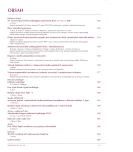Importance of implantable loop recorder in patients with unexplaided syncope
Authors:
R. Krausová
Published in:
Kardiol Rev Int Med 2007, 9(3): 177-181
Overview
Conventional tests have known limitations in the diagnosis of syncope. Implantable loop recorder (ILR) is capable to monitor continuously ECG over a period of several months with an option to record signals during a period of symptoms after post hoc telemetric activation. ILR is a useful diagnostic tool in syncopal patients with infrequent symptoms and negative results of previous conventional tests.
Keywords:
long-term ECG monitoring, unexplained syncope, implantable loop recorder, bradyarrhythmia, tachyarrhythmia
Sources
1.Day SC, Cook EF, Funkenstein H et al. Evaluation and outcome of emergency room patients with transient loss of consciousness. Am J Med 1982; 73: 15–23.
2.Kapoor WN, Karpf M, Weind S et al. A prospective evaluation and follow–up of patients with syncope. N Engl J Med 1983; 309: 197–204.
3.Zimetbaum PJ, Josephson ME. The evolving role of ambulatory arrhythmia monitoring in general clinical practice. Ann Intern Med 1999; 130: 848–856.
4.Kapoor WN. Evaluation and outcome of patients with syncope. Medicine 1990; 69: 160–175.
5.Gibson TC, Heitzman MR. Diagnostic efficacy of 24–hour electrocardiographic monitoring for syncope. Am J Cardiol 1984; 53: 1013–1017.
6.Clark PI, Glasser SO, Spoto E. Arrhythmias detected by ambulatory monitoring: Lack of correlation with symptoms of dizziness and syncope. Chest 1980; 77: 722–725.
7.DiMarco JP, Philbrick JT. Use of ambulatory electrocardiografic (Holter) monitoring. Ann J Med 1990; 113: 53–68.
8.Bass EB, Curtiss EI, Arena VC et al. The duration of holter monitoring in patients with syncope. Arch Intern Med 1990; 150: 1073–1078.
9.Linzer M, Pritchett EL, Pontinen M et al. Incremental diagnostic yield of loop electrocardiographic recorders in unexplained syncope. Am J Cardiol 1990; 66: 214–219.
10.Fogel RI, Evans JJ, Prystowsky EN. Utility and cost of event recorders in the diagnosis of palpitations, presyncope and syncope. Am J Cardiol 1997; 79: 207–208.
11.Kapoor WN, Smith NA, Miller NL. Upright tilt testing in evaluating syncope: a comprehensive literature review. Am J Med 1994; 97: 78–88.
12.Klein GJ, Gersh BJ, Yee R. Electrophysiological testing: the final court of appeal for diagnosis of syncope? Circulation 1995; 92: 1332–1335.
13.Brignole M, Alboni P, Benditt D et al. Task Force on Syncope, European Society of Cardiology. Guidelines on management (diagnosis and treatment) of syncope. Eur Heart J 2001; 22: 1256–1306.
14.Simantirakis EN, Chrysostomakis SI, Manios EG et al. Insertable loop recorder in unmasking the cause of syncope. Pacing Clin Electrophysiol 2000; 23: 1573–1575.
15.Sra JS, Anderson AJ, Sheikh SH et al. Unexplained syncope evaluated by electrophysiologic studies and head–up tilt testing. Ann Intern Med 1991; 114: 1013–1019.
16.Krahn AD, Klein GJ, Norris C at al. The etiology of syncope in patients with negative tilt table and electrophysiological testing. Circulation 1995; 92: 1819–1824.
17.Krahn AD, Klein GJ, Yee R et al. The etiology of syncope in patients with negative noninvasive and invasive testing: final results from a pilot study with implantable loop recorder. Am J Cardiol 1998; 82: 117–119.
18.Krahn AD, Klein G, Norris C et al. The etiology of syncope in patients with negative noninvasive testing: final results from a pilot study with an insertable lopp recorder. Pacing Clin Electrophysiol 1997; 20: 1077.
19.Krahn AD, Klen GJ, Yee R. Use of an extended monitoring strategy in patients with problematic syncope. Reveal Investigators. Circulation 1999; 99: 406–410.
20.Krahn AD, Klein GJ, Yee R. Recording that elusive rhythm. Can Med Assoc J 1999; 161: 1424–1425.
21.Krahn AD, Klein GJ, Yee R et al. Randomized assesment of syncope trial: Conventional diagnostic testing versus a prolonged monitoring strategy. Circulation 2001; 104: 46–51.
22.Seidl K, Breunung S, Rameken M et al. Initial experience with an implantable loop recorder in patients with unexplained syncope. Z Kardiol 2000; 89: 43–50.
23.Deharo JC, Jego CH, LanteaumeA et al. An implantable loop recorde study og highly symptomatic vasovagal patients. J Am Coll Cardiol 2006; 47: 587–593.
24.Moya A, Brignole M, Menozzi C et al. Mechanismus of syncope in patients with isolated syncope and in patients with tilt–positive syncope. Circulation 2001; 104: 1261–1267.
25.Ashby DT, Cehic DA, Disney P et al. A retrospective case study to assess the value of the implantabile loop recorder for the investigation of undiagnosed syncope. Pacing Clin Electrophysiol 2002; 25: 1200–1205.
26.Nierop PR, Van Mechelen R, Van Elsäcker A at al. Heart rhythm during syncope and presyncope: Results of implantable loop recorders. Pacing Clin Electrophysiol 2000; 23: 1532–1538.
27.Krausová R. Dlouhodobá EKG monitorace pomocí implantabilních systémů. V. české sympozium o arytmiích a kardiostimulaci, 7.–9. října 1998, Olomouc (abstrakt).
28.Brignole M, Menozzi C, Moya A et al. Mechanismus of syncope in patients with bundle branch block and negative electrophysiological test. Circulation 2001; 104: 2045–2050.
29.Muller U, Jochheim R, Knaup W et al. Implantable event recorder: a new aid for the diagnosis of arrhythmogenic syncope. Dtsch Med Wochenschr 1998; 123: 1378–1382.
30.Vardas PE. From the Einthoven galvanometer to the implantable loop recorder: Revelations in store. Pacing Clin Electrophysiol 2000; 23: 1453–1455.
31.Giada F,Gulizia M, Francese M. Recurrent Unexplained Palpitations (RUP) Study. J Am Coll Cardiol; 49: 1951–1956.
32.Brignole M, Alboni P, Benditt DG et al. Guidelines on management (diagnosis and treatment) of syncope–update 2004. Europace 2004; 6: 467–537.
33.Klein G, Yee R, Gonsales J et al. Cost effective analysis of diagnostic strategies in syncope of unknown etiology. Circulation 1998; 94(Suppl I): 3655.
34.Krahn AD, Klein GJ, Yee R, Manda V. The high cost of syncope: cost implications of a new insertable loop recorder in the investigation of reccurent syncope. Am Heart J 1999; 137: 870–877.
35.Assar MD, Krahn AD, Klein GJ et al. Risk of reccurent syncope after negative implantable loop recorder monitoring: Long–term follow–up of 26 patients. Pacing Clin Electrophysiol 2002; 25: 571 (abstrakt).
Labels
Paediatric cardiology Internal medicine Cardiac surgery CardiologyArticle was published in
Cardiology Review

2007 Issue 3
Most read in this issue
- Monitoring peroral anticoagulation therapy in outpatient practice
- Importance of implantable loop recorder in patients with unexplaided syncope
- CURRENT MEDICAL LITERATURE LTD, LONDON 1998, 438S.
- Pulmonary arterial hypertension
